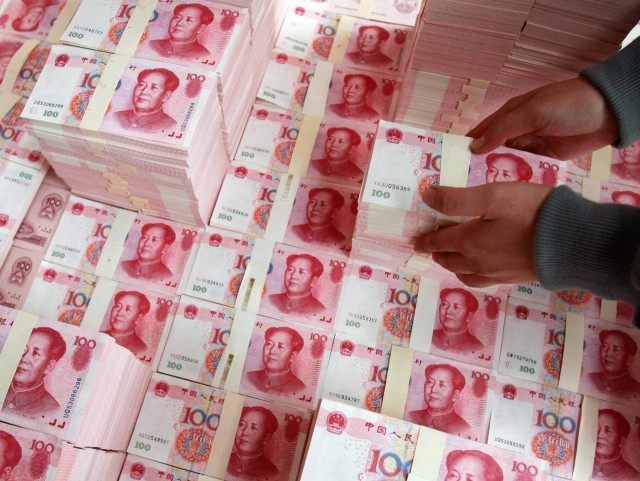With a “predatory” currency devaluation following the Brexit, China is now exporting deflation.
Although China still pumps out positive economic data about the success of its export-driven economy, the annual growth rate of the nation’s internal investments in fixed capital assets, such as new manufacturing plants and housing, has continually fallen from over 33 percent in 2009 to 9.6 percent in May 2016.
The easiest way for China to continue expanding their exports would have been to devalue the yuan exchange rate to become more price competitive. But at 13.8 percent of the world’s export volume in 2015, any Chinese currency devaluation would have been seen as a “predatory” job raid by China’s on its top trade partners, the European Union and the United States.
Worried about growing retaliatory tariffs, such as America slapping a 500 percent tariff increase on certain types of steel imports, China’s Premier Li Keqiang solemnly pledged in January to continue a ”stable yuan” exchange rate of 6 to 6.5 yuan for each U.S. dollar. The Premier tried to reassure the international community that “China has no intention of stimulating exports through competitive currency devaluation.”
Although Donald Trump and Bernie Sanders have wailed away at China for currency manipulation in the 2016 presidential election campaign, the stable yuan policy over the last two years has cost China $800 billion in foreign exchange to prevent a devaluation.
But Breitbart News warned last October that with the fastest foreign exchange burn-rate in the history of the planet, “China only has 2 Years of Currency Reserves” before it faces a solvency crisis due to not enough foreign exchange to purchase enough raw materials and sub-assembly imports to sustain its huge export-driven economy.
Although the official People’s Bank of China data claims foreign exchange holdings were virtually unchanged at $3.2 trillion in June, traders report that China purchased about $28 billion in yuan to prevent a yuan devaluation just prior to the Brexit vote.
With the magnitude of the June 23 “Brexit” shock causing an 11 percent overnight devaluation of the British pound, the “contagion” accelerated China’s solvency crisis.
Coming into the crisis, China had a low government debt to gross domestic product (GDP) ratio of 43.9 percent. But with the Communist Party entwined in almost every aspect of lending and business, China may be responsible for the nation’s total debt of $25 trillion, which as of March officially amounted to a stunningly 237 percent of GDP.
According to the Bank of International Settlements, China’s official debt ratio is only slightly less than the EU’s 270 percent of GDP and the U.S. level of 248 percent of GDP.
And the “Red Dragon” has been notoriously dishonest in hiding just how much cash in export subsidies, tax breaks, and cheap state credit the Communist Party is willing to squander to try to maintain domestic jobs. A widely cited report by McKinsey & Company estimated that China’s real debt ratio was 282 per cent of GDP in mid-2014.
Reuters reported that just after the Brexit vote, “China’s national audit department reviewed the financials of the 10 largest state-owned companies including Aluminum Corporation of China, Sinopec and China National Offshore Oil Corporation, exposing huge losses in these firms as a result of low efficiency and bad investment decisions.”
Whatever the true leverage of China’s debt-to-GDP ratio, the International Monetary Fund warned in April that China’s present level of debt and its increasing links to global financial markets pose a growing risk to advanced economies. The IMF fears that at some point, China loans turning sour could spiral down on the global economy.

COMMENTS
Please let us know if you're having issues with commenting.